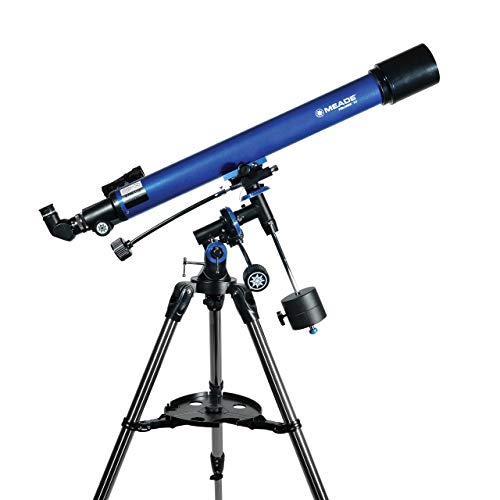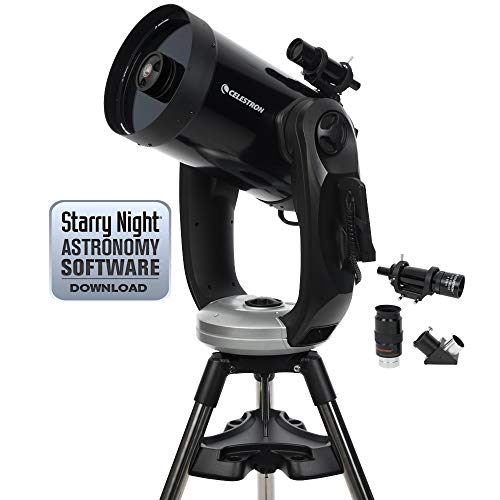Meade vs Celestron Telescopes: Which is Better?
Last Updated on
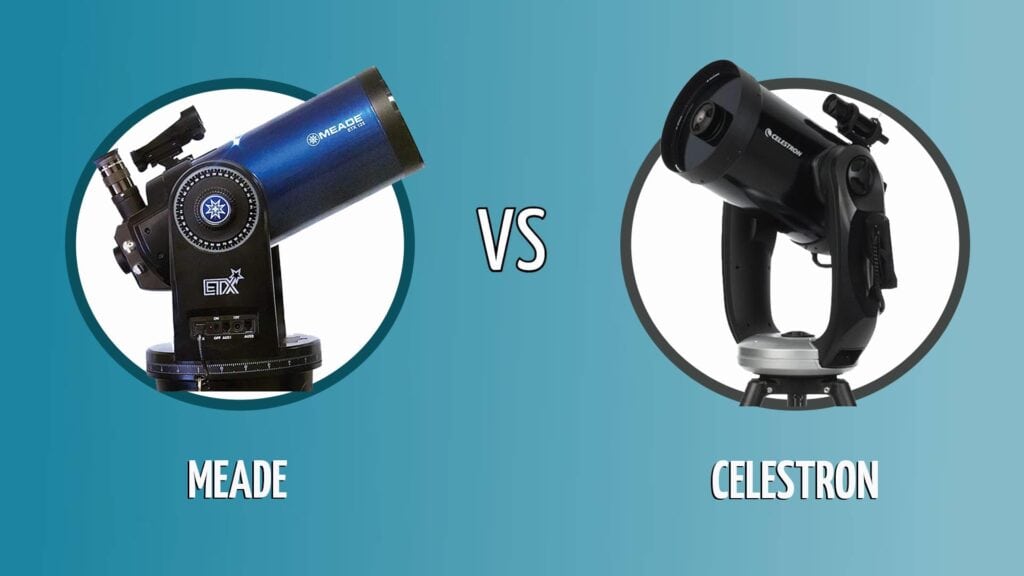
When it comes to astronomy, few companies have pushed the bounds of what is possible like Meade and Celestron. They’re two of the most prominent and well-respected telescope manufacturers in the world, and both of them make top-notch products that span from beginner-friendly models to the top-tier telescopes used by professional astronomers the world over.
So, how could you possibly choose between the two? Both offer telescopes with great features like GoTo, GPS, and high-quality optics. Truthfully, you can’t go wrong with either brand. But to help you decide where to spend your money, we’re going to take an in-depth look at each company and their offerings so you can make the most informed decision possible.
Meade vs Celestron: At a Glance
| Meade | Celestron | |
| Established | 1972 | 1964 |
| Manufactured in | Taiwan and Irvine, CA | Taiwan |
| Beginner-friendly | Yes | Yes |
| Price range | $45 – $19,000 | $50 – $8,700 |
| Warranty | 1-year | 2 years to limited lifetime |
About Meade
Originally started as a mail-order company shipping out reflector telescopes, Meade grew into a prominent name in the industry. They’re known for making high-quality telescopes equipped with their Advanced Coma-Free optics.
Meade’s goal is to use advanced technology to make astronomy accessible, easy, and fun for everyone, regardless of experience level. Their wide range of consumer-level astronomy tools makes this clear, and they’ve made it affordable for anyone to get started observing the night skies.
But that doesn’t mean they only make beginner-friendly equipment. On the contrary, Meade makes some incredibly high-end telescopes that are meant for observatories and the discerning eyes of the world’s leading astronomy professionals. Over the years, they’ve built a trusted reputation by producing quality devices that continue to expand our reach into the stars.
What Meade Has to Offer
Meade sells quality astronomy tools of all types, including telescopes, eyepieces, lenses, binoculars, spotting scopes, and more. Their telescopes range from the basic and beginner-friendly models that start below the $50 mark all the way up to $19,000 telescopes with Ultra-High Transmission Coatings and 16-inch focal lengths. No matter what stage you’re at in your astronomy journey, Meade has the tools to help you continue progressing.
Top Meade Models
If you’re just getting into astronomy and you’re looking for the basic tools to get started, Meade has some of the most affordable offerings available. For under $50, you can get their Infinity series 50-millimeter refracting telescope with a precision Alt-azimuth mount, three eyepieces with different levels of magnification, and an aluminum tripod for mounting.
For a bit more, you can step up to their Adventure Scope or StarPro AZ lines. Here you can move up from a 50-millimeter refractor to a 70-millimeter refractor with a 700-millimeter focal length and slow-motion control cables.
Beginner
Even if you’ve never touched a telescope before, Meade’s beginner lineup has you covered.
Polaris 70mm Refracting Telescope
When purchasing a beginner telescope, you’re looking for something that’s a good all-around tool to let you see if you really enjoy astronomy before you invest heavily in an expensive telescope. The Polaris 70mm Refracting Telescope is an affordable device with everything you need to get started in astronomy. It performs admirably for its price, enabling you to see things like Jupiter’s moons or detailed close-ups of our own moon’s surface.
The included equatorial mount and slow-motion controls can be a bit difficult to set up and learn. But once you do, you will be able to easily locate and track different celestial bodies with ease as the equatorial mount makes it possible to follow their arc through the sky. It’s going to take some practice, but you will learn a lot along the way!
You’ll also get three different eyepieces that offer varying degrees of magnification. They’re not the highest quality though. If you’re going to make an upgrade, the eyepieces would be the thing to upgrade. But you do get a helpful 2x Barlow lens that will double the magnification of any eyepiece. Combined with the three eyepieces, you’ll have six levels of magnification to choose from.
- Affordably priced
- Includes tripod and EQ mount
- Three eyepieces are included for different magnification
- 2x Barlow lens means you get 6 different levels of magnification
- Eyepieces are of low-quality
- Can be difficult to set up and learn to use
Intermediate
In Meade’s intermediate range, you get a lot of options. Starting in the mid-three-hundreds, you get great choices like the StarNavigator series or the Observer. In this range, you get great options like the AudioStar Hand Controller that lets you choose from over 30,000 celestial objects that the telescopes can find.
But you’ll find some higher-end telescopes at the top of the intermediate range as well. Offerings such as the LX65 series bring large f/12 focal ratios and long focal lengths to help you see the detail in far-off objects in space. The eyepieces have now been upgraded as well, so your choices are numerous and powerful.
ETX125 Observer – 127mm Aperture Maksutov
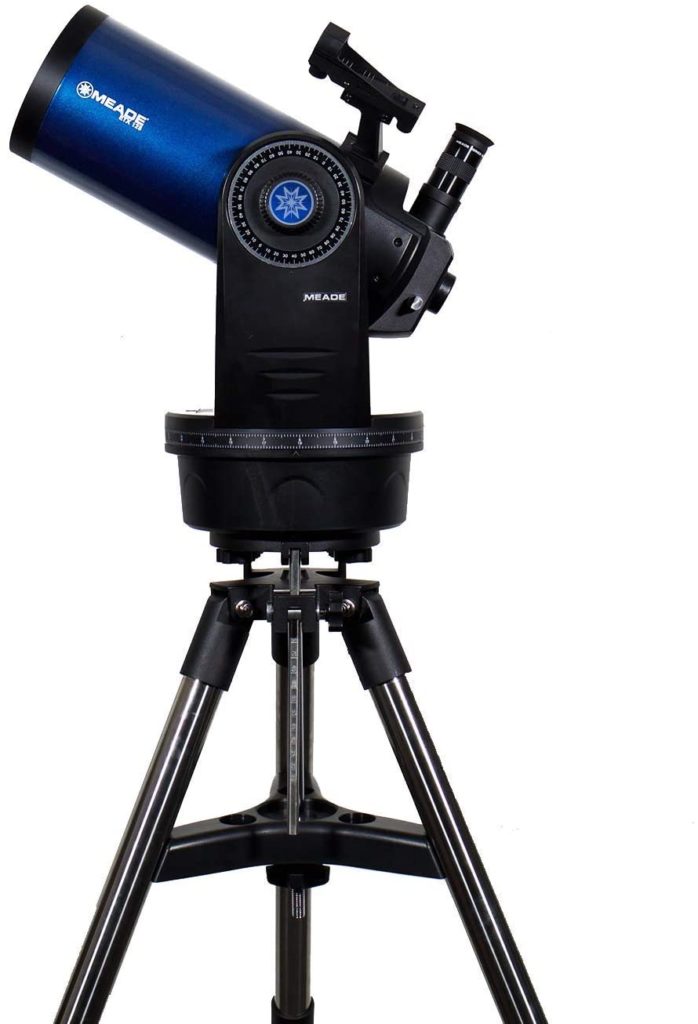
With a massive f/15 focal ratio and a 1900-millimeter focal length, the ETX125 Observer is well-equipped to help you see the heavens like never before. But that’s not where the great features stop. you also get two high-quality Super Plossl eyepieces; seven-millimeter and 26-millimeter.
One of the best features on this telescope and the others in Meade’s intermediate-range is the AudioStar computer hand controller they’re equipped with. It’s got a database that’s filled with 30,000 celestial objects for you to choose from.
Using AudioStar, you can point the telescope at any of them with the push of a few buttons, saving you the time and frustration of locating them manually. But it’s a bit difficult to set up and get aligned. And the software is known to be a bit finicky, which holds the telescope back a little.
Where this telescope shines is portability. It’s only 25 pounds, light for a telescope with a 127-millimeter aperture. This means you can take it with you to those areas where the stars are most visible, enabling you to make the best use possible of that large aperture.
- Large 127mm aperture lets in lots of light
- Light and portable
- Includes two Super Plossl eyepieces
- Equipped with AudioStar computer hand controller
- AudioStar can be finicky and hard to align
Advanced
Meade has no shortage of advanced telescopes for you to choose from. Discerning professionals in the astronomy field often choose Meade telescopes because of their high-end features, high-quality optics, and diverse options.
In the low $2,000s, you have options such as the LX90 or the LX200. In this range, you get Meade’s patented Ultra-High Transmission Coatings, Super Plossl eyepieces, and the AutoStar II computer system, a major upgrade from the AudioStar system found on the intermediate lineup of telescopes.
Also standard in this range are great features like a built-in 16-channel GPS receiver that makes for fast, precise star alignment. Heavy-duty dual-fork mounts or GoTo German Equatorial Mounts are also found on some of these telescopes, depending on what type of telescope you’re looking for.
These telescopes can get astronomically expensive though, reaching $18,999. In this range are some of the most advanced telescopes in the world, and they’ll satisfy the needs of any astronomer.
LX200-ACF Advanced Coma-Free Telescope
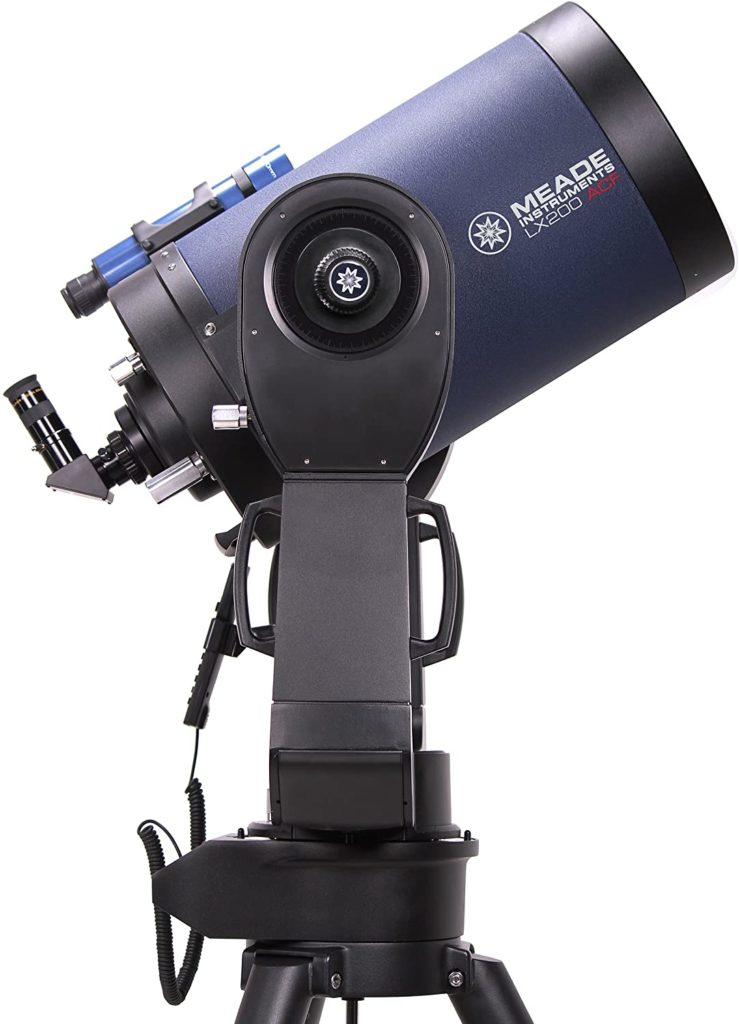
Quality often costs more, but it’s usually a case of getting what you pay for. Such is the situation with the LX200-ACF telescope. This advanced coma-free telescope has an f/10 focal ration with a 2,000-millimeter focal length. But the lenses also have Ultra-High Transmission Coatings, which allows for up to 15% more light transmission. This means you can see finer details and brighter images so you can extend your reach into space.
The shining star of this telescope is the AutoStar II computer system. It takes celestial databases to new heights with a 145,000 object library. It’s also got multiple guided tours built-in. But the best feature is how quickly it can align and find any object you ask for. It’s easy to use and the telescope’s 16-channel GPS receiver helps to ensure that you’re always properly aligned without any frustration.
On the downside, all the motors that move this telescope and make the alignment and movement so easy also make a lot of noise. They’re pretty loud, but if you can deal with the noise, this telescope is loaded with great features and top-notch optics for any advanced astronomer.
- Aligns easily and quickly with AutoStar software
- Heavy-duty double-fork mount
- Battery-powered or universal AC adapter available
- Includes 26mm Plossl eyepiece
- The motors are a bit noisy

About Celestron
With the longest selling mass-produced telescope under their belt, the C8, Celestron has become a well-known and respected name in astronomy. They make a wide array of telescopes from beginner models to get you started up to high-tech professional models that cost thousands of dollars.
Celestron is recognized as one of the most prestigious names in telescopes. They’ve been making and selling high-quality optics since the early 1960s, and that tradition continues today.
What Celestron Has to Offer
Starting at a mere $50, Celestron has models for every level of budding astronomer. They have many models designed to get you started in astronomy and allow your love for it to grow. But they also have some telescopes that near $10k in price, such as the CGX-L telescope at $8699.
No matter what type of telescope you end up choosing, Celestron stands behind them all with a two-year warranty. Even better, they provide a limited lifetime warranty on the basic optical system for the lifetime of the product under the original owner.
With one of the best warranties in the industry backing up their products and many diverse telescopes to choose from at all levels, it’s easy to see why so many people trust Celestron for their astronomy needs.
Top Celestron Models
Beginner
For those just getting started with astronomy and looking for an inexpensive way to explore the hobby, Celestron has many great offerings with impressive features and quality optics for the price. Their PowerSeeker and FirstScope series both start around $50 and provide a quality starting point for anyone unsure of astronomy and looking for a way to dip their toe in.
Under $100, you have more than a dozen options to choose from. The ExploraScope and AstroMaster telescopes start to up the ante with all coated glass optics, durable steel tripods, and crisp images that let you enjoy your first glances into the cosmos.
The same PowerSeeker and AstroMaster ranges get a bit more expensive as you approach the $200 mark, offering improved optics, multiple eyepieces, and high-quality alt-azimuth controls.
PowerSeeker 50AZ Refractor Telescope

For those who are just getting into the science and art of astronomy, there are few better telescope choices than the PowerSeeker 50AZ. This telescope is dirt-cheap but offers quality viewing that won’t hold you back as you get started in astronomy.
Included is everything you need to get started. You’ll get a full-height tripod to hold the telescope with a smooth and accurate yoke mount and slow-motion altitude rod. They make it easy to get things adjusted so you can locate the celestial bodies you most want to observe.
You’ll also receive four eyepieces, a 1.5x erecting eyepiece, and three magnifying eyepieces at 30x, 50x, and 150x. If this doesn’t already seem like enough to get you started, you also get a 3x Barlow lens. This will multiply any lenses magnification by 3x, effectively providing you with six different usable levels of magnification.
This is also a lightweight and portable device at just five pounds fully assembled. That’s great if you want to take it out to your favorite campsite where the skies are dark at night. But that also means it’s easy to knock out of alignment, so be careful not to bump it!
- Makes astronomy affordable for everyone
- Lightweight and compact
- Full height tripod included
- Four eyepieces included
- Weighs just 5 pounds assembled
- Easily knocked out of alignment because of its light weight
Intermediate
Celestron has just as many diverse mid-range offerings for the intermediate-level astronomer who needs a bit more power and some more functionality from their telescope.
Starting around $400, you get great features like smartphone app-enabled software that will give you a guided tour of the universe using the telescope. You also get smooth slow-motion controls for precise manual movement. Using them together, you can follow the arrows on the app to point to different deep sky objects that the app finds that will be visible from where you are.
If you spend a bit more, some incredible features start popping up around $1,000. For instance, in this range, you can get a fully computerized telescope. Even better, now they’re equipped with fully automated GoTo mounts that can find and track over 40,000 celestial objects, taking your astronomy to new heights.
NexStar 6SE Telescope
If you’re new to intermediate-level telescopes, you can expect a steep learning curve with the NexStar 6SE Telescope, but don’t let that scare you off. Once you learn and understand how this device operates, you’ll never want to view space through a beginner telescope again.
What makes this telescope special is the fully automated GoTo mount. It can find and track over 40,000 celestial objects, making it easier and more fun for you to observe the deep sky.
But these software programs can be difficult to set up and align, which is why this telescope is equipped with SkyAlign. SkyAlign makes it quick and easy to get your telescope aligned and ready to find.
Combined with the collapsible steel tripod, you’re ready to take your NexStar 6SE Telescope anywhere you want for the best viewing of the heavens. And since it’s just 30 pounds fully assembled, you’ll have no problem taking it in your car to your favorite viewing spot.
- Automated GoTo mount with over 40,000 celestial objects
- SkyAlign technology for quick setup
- Sturdy tripod and mount
- Reasonable price point
- Maksutov design less flexible than SCT
- Field of view on the smaller end
Advanced
In the advanced range, Celestron telescopes are some seriously well-equipped tools. Starting around $2,000, the Advanced VX700 lineup comes with the Advanced VX, the most portable and compact German equatorial mount that Celestron makes. You also get an impressive f/15 focal ratio that makes it possible to see detailed views of far off planets and lunar landscapes.
Move up a little further and the optics improve even more. You’ll get StarBright XLT coatings that allow for maximum light transmission. This makes it possible to see space objects in greater detail than ever before.
CPC 1100 StarBright XLT GPS Schmidt-Cassegrain 2800mm Telescope
The CPC 1100 StarBright XLT Schmidt-Cassegrain Telescope offers some impressive features that are perfect for professional astronomers. The 11-inch optical tube offers sharp and clear images, aided by the StarBright XLT optical coatings that allow for maximum light transmission, allowing you to see detail in far-off celestial bodies.
One of the best features of the CPC 1100 is that it’s fully-computerized with a built-in GPS. This makes it easy to align and just as easy to find and locate any of over 40,000 celestial objects in the built-in database. Just enter the object you want to view and the computer will find and follow it so you can sit back and observe.
But don’t expect to take this telescope camping with you like you might take one of the intermediate-level telescopes in the Celestron lineup. This one weighs 92 pounds fully assembled, so you’ll probably want to leave it one place for continued use.
- Fully computerized dual fork Azimuth mount
- Includes heavy-duty tripod with 2” steel legs
- Remote hand controller lets you make adjustments while viewing
- Internal GPS can locate 40,000 different celestial objects
- It’s quite an investment
- Heavy
Conclusion
There’s no debate, Meade and Celestron both make excellent telescopes of all levels. From the beginner first starting to dabble in astronomy to the professional who’s made a career of it, either company has great telescopes with the features you need to continue advancing at your craft.
In the beginner range, both offer great models and you can’t go wrong with either company. When it comes to intermediate-level telescopes, Celestron’s 40,000+ celestial object database with GoTo technology and SkyAlign for easy alignment beat the smaller celestial library and more cumbersome setup process offered by Meade.
But at the high end of the spectrum, Meade tips the scales in their favor with the advanced AutoStar II computer system that has a celestial library of 145,000 objects. Still, you can’t go wrong with a telescope from either brand at any level. They both make great telescopes for all astronomers from enthusiasts to professionals.
About the Author Robert Sparks
Robert’s obsession with all things optical started early in life, when his optician father would bring home prototypes for Robert to play with. Nowadays, Robert is dedicated to helping others find the right optics for their needs. His hobbies include astronomy, astrophysics, and model building. Originally from Newark, NJ, he resides in Santa Fe, New Mexico, where the nighttime skies are filled with glittering stars.
Related Articles:
How to Clean a Refractor Telescope: Step-by-Step Guide
How to Clean a Telescope Eyepiece: Step-by-Step Guide
How to Clean a Rifle Scope: 8 Expert Tips
Monocular vs Telescope: Differences Explained (With Pictures)
What Is a Monocular Used For? 8 Common Functions
How to Clean a Telescope Mirror: 8 Expert Tips
Brightfield vs Phase Contrast Microscopy: The Differences Explained
SkyCamHD Drone Review: Pros, Cons, FAQ, & Verdict

